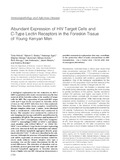Abundant Expression of HIV Target Cells and C-Type Lectin Receptors in the Foreskin Tissue of Young Kenyan Men
Date
2010Author
Hirbod, Taha
Bailey, Robert C
Agot, Kawango
Moses, Stephen
Ndinya-Achola, JO
Murugu, Ruth
Andersson, Jan
Nilsson, Jakob
Broliden, Kristina
Type
ArticleLanguage
enMetadata
Show full item recordAbstract
A biological explanation for the reduction in HIV-1 (HIV) acquisition after male circumcision may be that removal of the foreskin reduces the number of target cells for HIV. The expression of potential HIV target cells and C-type lectin receptors in foreskin tissue of men at risk of HIV infection were thus analyzed. Thirty-three foreskin tissue samples, stratified by Herpes simplex virus type 2 status, were obtained from a randomized, controlled trial conducted in Kenya. The samples were analyzed by confocal in situ imaging microscopy and mRNA quantification by quantitative RT-qPCR. The presence and location of T cells (CD3+CD4+), Langerhans cells (CD1a+Langerin/CD207+), macrophages (CD68+ or CD14+), and submucosal dendritic cells (CD123+BDCA-2+ or CD11c+DC-SIGN+) were defined. C-type lectin receptor expressing cells were detected in both the epithelium and submucosa, and distinct lymphoid aggregates densely populated with CD3+CD4+ T cells were identified in the submucosa. Although the presence of lymphoid aggregates and mRNA expression of selected markers varied between study subjects, Herpes simplex virus type 2 serostatus was not the major determinant for the detected differences. The detection of abundant and superficially present potential HIV target cells and submucosal lymphoid aggregates in foreskin mucosa from a highly relevant HIV risk group demonstrate a possible anatomical explanation that may contribute to the protective effect of male circumcision on HIV transmission.
Citation
Am J Pathol. 2010 June; 176(6): 2798–2805.Description
Full text
Collections
- Faculty of Health Sciences (FHS) [10387]

